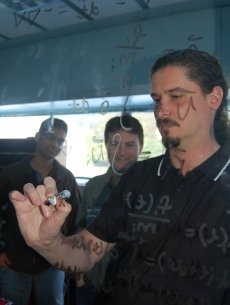Computational Nanotechnology
Computational Nanotechnology
Prof Shaun Hendy | Dr Nicola Gaston
We study nanoparticles using computer models to predict their behaviour and inform real life nanoparticle physics and chemistry.
Our work can be likened to carrying out a chemical experiment in a computer, rather than a test-tube. Instead of mixing reagents, we programme a computer with the quantum mechanical properties of the chemicals, hit 'start' and observe the molecular interactions that follow. This is 'chemistry in silico'.

Simulations showing the difference in bouncing angles between a solid (left) and a liquid nanoparticle.
Computational nanotechnology is a powerful tool for understanding nanoparticle physics and chemistry. After carrying out a simulated experiment, theory is developed to explain the observed results, which is then validated by conducting a lab experiment. If the predicted results and the theoretical results agree, then the theory is accepted. Unexpected results from laboratory work can also be examined with theoretical methods, which often lead to the development of new theory.

Nat Lund explains a subtle point in nanofluidics
Different scales of a reaction can be studied with computational methods - from 1000 to 6 million atoms. Larger scale computational work involves using the Blue Fern Supercomputer Centre and experiments can take from five minutes to five weeks. Graphics programmes allow us to progressively visualise atom configuration and movement on timescales much shorter than it is possible to see in the lab.
Collaborations
Our work is closely linked with the Nanoparticle and Quantum Dot Research group at Victoria University, with Industrial Research Ltd and the University of Canterbury, through the MacDiarmid Institute for Advanced Materials and Nanotechnology. We also participate in a number of international collaborations including groups at Imperial College London, the University of Tennessee, Stanford University, UC Berkeley and CSIRO Melbourne.
